Fresh Baked Deliciousness
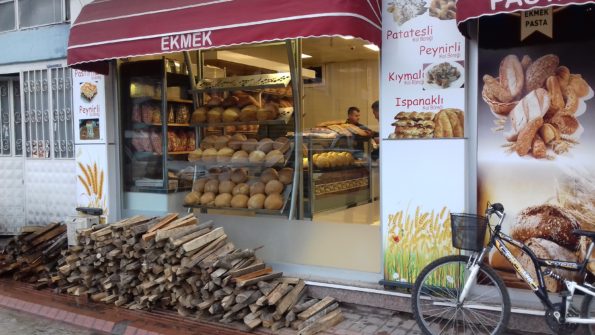 Although ekmek, bread, is an undeniably important part of Turkish cuisine, it is also an incredibly important part of Turkish culture, history and religion. Bread is such a key ingredient of each meal that to not serve it is to have an incomplete meal. (I know this first-hand because it was reinforced the hard way once when I served a lovely 2-course meal and my guest’s only comment was how she was left unsatisfied because there was no bread.) Very simply put, if there’s no bread, there’s simply no meal. When ordering soup at a restaurant or café, you will be presented with a huge basket overflowing with fresh bread. As the main course arrives, it’s not uncommon for the basket to need to be replenished as the bread is used to soak up the juices during the meal.
Although ekmek, bread, is an undeniably important part of Turkish cuisine, it is also an incredibly important part of Turkish culture, history and religion. Bread is such a key ingredient of each meal that to not serve it is to have an incomplete meal. (I know this first-hand because it was reinforced the hard way once when I served a lovely 2-course meal and my guest’s only comment was how she was left unsatisfied because there was no bread.) Very simply put, if there’s no bread, there’s simply no meal. When ordering soup at a restaurant or café, you will be presented with a huge basket overflowing with fresh bread. As the main course arrives, it’s not uncommon for the basket to need to be replenished as the bread is used to soak up the juices during the meal.
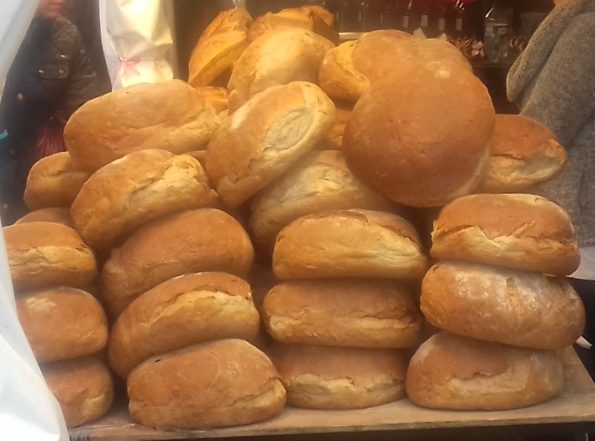 Though widely enjoyed today, bread is not new to Turkey. Nomadic Turks ate bread over a millennia ago. During the Ottoman period, Adam was known as the Patron Saint of Bakers. It is believed that, after being kicked out of the Garden of Eden, he learned how to bake bread from the Archangel Gabriel. This explains why Turks are so proud of their bread and believe it to be the best-tasting in all the world.
Though widely enjoyed today, bread is not new to Turkey. Nomadic Turks ate bread over a millennia ago. During the Ottoman period, Adam was known as the Patron Saint of Bakers. It is believed that, after being kicked out of the Garden of Eden, he learned how to bake bread from the Archangel Gabriel. This explains why Turks are so proud of their bread and believe it to be the best-tasting in all the world.
In fact, bread is equated with life itself. There is a Turkish phrase, ekmek parası, (“Bread Money”) which means the money one lives off of. Bread is a unique commonality between the wealthiest Turks and the poorest. Bread is considered “peasant food.” This, however, only refers to the fact that bread is easy to make, cheap and very filling. It doesn’t imply that the wealthy don’t value and eat it just as much as the poor. It is considered a great insult, a sin even, to throw away any left-over bread. Just walking down the street you can easily see bags of bread tied to fences, hanging from tree branches or left on top of low walls. Rich Turks believe that you should never waste bread because one day you might be poor yourself and regret the time you wasted what bread you had. Consequently, any bread left at the end of the day will be placed outside for the poor, the birds and the street animals to eat. This almost sacred quality of bread is also clearly seen during the baking process. Bakers invoke the name of Allah before placing the bread in ovens to bake.
 If you visit Istanbul, or any other large city in Turkey, you are sure to see a fırın on each street corner… and several in between as well. Fırın literally means “oven” but is used here to refer to a bakery. When I lived in a much smaller city in the southeast almost 2 decades ago, I loved how community life happened around the local fırın. Since most homes didn’t have an oven of their own (only a small stove or propane burners), it was normal to prepare a dessert, casserole, or pizza and drop it off at the local fırın on your way to work. On your way home, simply stop by and pick up the freshly baked item and go home to a hot meal! While this doesn’t happen today in large cities, bakeries are still a very busy and social place. Most bakeries bake bread fresh 3 times each day. Oh yes, freshness is key here! It would definitely not be acceptable to buy week-old sliced bread in a package from the supermarket. Oh no. Most Turks will go to the bakery three times a day for fresh bread before each meal. You know when the bread is fresh because there will be a line forming at the bakery and an amazing aroma in the air. After tasting even the cheapest loaf of bread fresh from a bakery oven there’s no way you will be able to go back to store-bought bread!
If you visit Istanbul, or any other large city in Turkey, you are sure to see a fırın on each street corner… and several in between as well. Fırın literally means “oven” but is used here to refer to a bakery. When I lived in a much smaller city in the southeast almost 2 decades ago, I loved how community life happened around the local fırın. Since most homes didn’t have an oven of their own (only a small stove or propane burners), it was normal to prepare a dessert, casserole, or pizza and drop it off at the local fırın on your way to work. On your way home, simply stop by and pick up the freshly baked item and go home to a hot meal! While this doesn’t happen today in large cities, bakeries are still a very busy and social place. Most bakeries bake bread fresh 3 times each day. Oh yes, freshness is key here! It would definitely not be acceptable to buy week-old sliced bread in a package from the supermarket. Oh no. Most Turks will go to the bakery three times a day for fresh bread before each meal. You know when the bread is fresh because there will be a line forming at the bakery and an amazing aroma in the air. After tasting even the cheapest loaf of bread fresh from a bakery oven there’s no way you will be able to go back to store-bought bread!
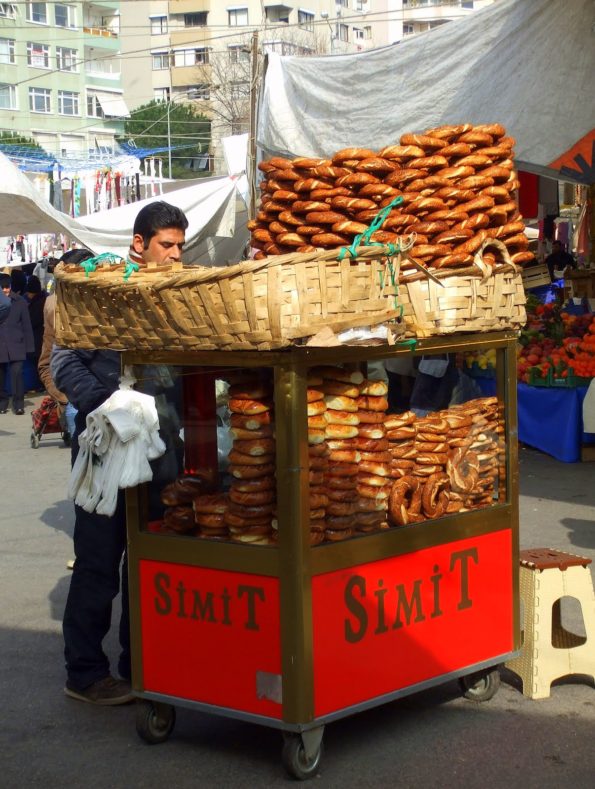 The varieties of bread in Turkey really are endless and differ according to region. However, a few basic types include: a traditional flatbread called pide (pita), simit (bread ring coated with sesame seeds), beyaz ekmek (white bread) as pictured here which is the traditional crusty loaf with soft white inside, round loaves of village bread and a variety of börek (like tepsi börek or sigara böreği), and gözleme.
The varieties of bread in Turkey really are endless and differ according to region. However, a few basic types include: a traditional flatbread called pide (pita), simit (bread ring coated with sesame seeds), beyaz ekmek (white bread) as pictured here which is the traditional crusty loaf with soft white inside, round loaves of village bread and a variety of börek (like tepsi börek or sigara böreği), and gözleme.
With such a great variety of breads it’s no surprise that the baking process is just as varied. Gözleme, for example, is cooked on a convex iron griddle directly over a flame. Several breads, such as pide, are baked by a process called “pebble baking” where the prepared dough is placed directly on the stone which is then heated. Some breads are baked in traditional pans such as we use in the US. Another beloved style of baking bread is an outdoor clay oven called tandır. These clay ovens (as pictured below) are usually found in villages where they are built outside, beside the family home. If you happen to walk by just as bread is being pulled out, you will be so very glad for the amazing Turkish hospitality and offer of a sample. There is nothing quite like the melt-in-your-mouth experience of biting into a hot piece of freshly baked bread!
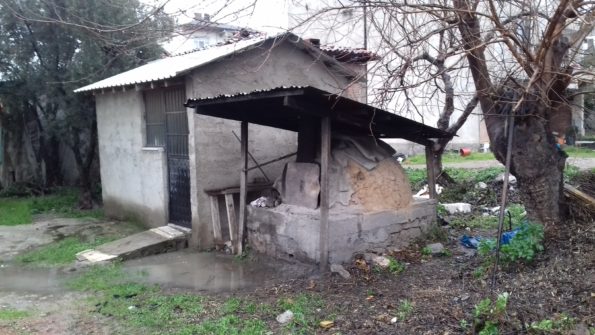
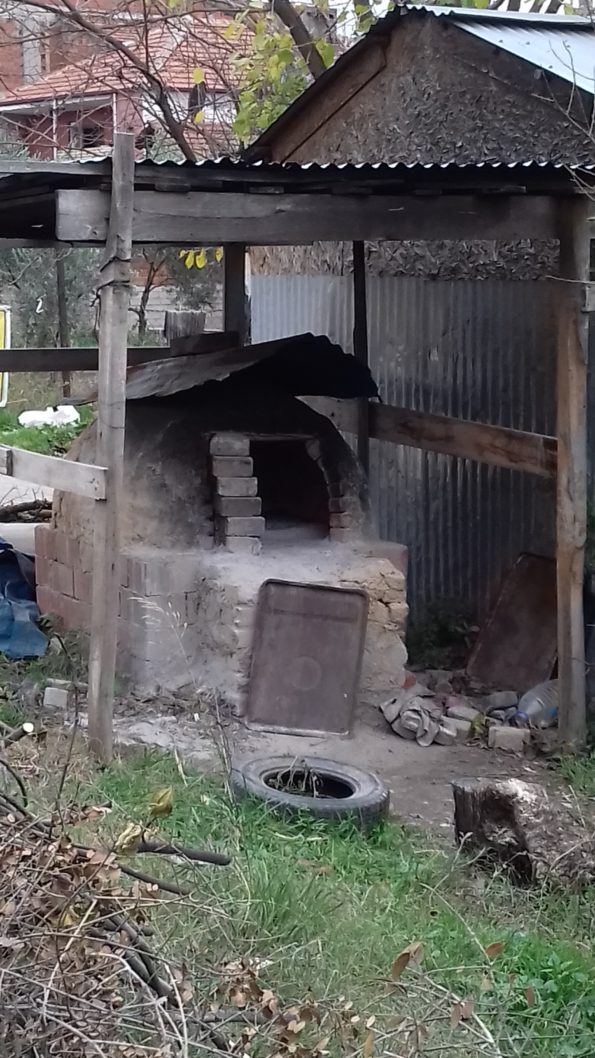



Randall Mason
Have you found substantive differences in the types of wheat used? I know my mother lived in post-war Europe and they all complained about the high gluten content of the imported wheat varieties ruining their recepies.
Jale
To be honest, I’m still trying to figure out all of the different flours that are available here. In the US I made my own bread all the time and experimented with many different varieties. However, in Turkey, bread is so inexpensive, fresh, and available that I generally just go to the local bakery and buy my bread since living here. I’m not sure how they do it, but they have definitely figured out some amazing bread recipes! I hope to continue learning more about this topic.